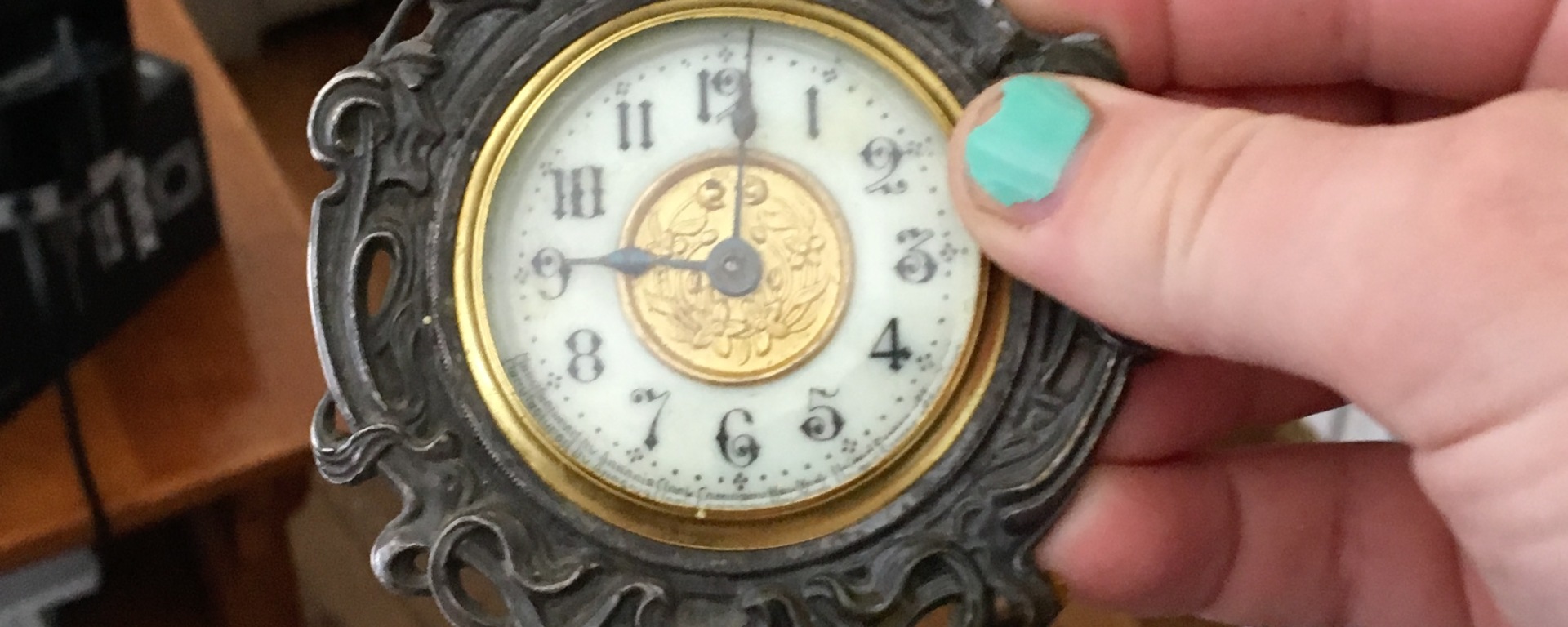I bought this small defunct clock on eBay for $28.00 + $11.42 for shipping. Why extend past my normal range of $5-15? Because this is an Ansonia.
For a more complete history I direct you to www.antiqueansoniaclocks.com. In brief, it existed from 1850 to 1929 and was successful in part due to its collaboration with a brass company and their use of brass in clockmaking.
So where is the hang up? This clock should be awesome to clean up and profitable to sell, right?! If only.
There is no Ultimate Clock Database online where I can type in “Antique Ansonia silver-colored metal miniature wall clock”. First of all, there are too many variables. One clock maker may call it miniature while another says petite. Secondly, this may not be an Ansonia clock. “But Margaret!” you protest. “EBay told you it was Ansonia and the dial says Ansonia!” Well yeah guys, but eBay is a liar. And the dial (the clock face) may have been pilfered from another clock, sadly. It wouldn’t necessarily be the fault of the eBay seller – yes, some people make a living off of selling things on eBay. But how many cute old ladies or overly trusting friendly people are out there, getting confused by a salesperson who says they’re selling “an Ansonia-style clock”? The new owner calls it Ansonia, and it’s inherited or passed along the family chain and suddenly here I am with a clock that looks unlike anything the Ansonia Clock Co ever made but with an Ansonia dial.
So besides the research, I began by polishing it.
Uh, wow!
Uhhh… WOW.
So here we are. Silver-colored metals possible are silver (too expensive), steel (it doesn’t shine quite bright enough), brushed nickel (again, not quite the right shine), or… *drumroll* pewter.
Thus began my epic quest to find where someone in the Americas would find enough pewter to make a (small) clock.
Now, pewter has traditionally been an English export. It was used widely as tableware in the Colonies when silver was not an option because of price. However, “the introduction of electroplating in the 1850s enabled metalworkers over brittania [Author’s Note: a type of tin] or a similarly hard metal to create silver plating, which most people preferred to the pewter finish.” (p.62, LeFever) So perhaps this is a metal (tin, steel, or something else) with silver plating. I’ll keep researching and if anyone has any ideas feel free to comment!
Now onto the fixing.
First of all, I wanted to clean the spring which was looking like it needed a good shine. Taking that off required taking all the gears off. Below is a picture of the spring post-cleaning, once I finally managed to get it back in place. Getting it back on was the hardest part. See the small column almost central in the brass fixture? That protects the gears of the clock from the spring, so I needed to wind the spring tight enough to fit inside of that boundary. That’s pretty tough when nothing is holding the spring in place! Unfortunately my handy spring clamps aren’t small enough for this job.

Putting the gears back together wasn’t too complicated. Unfortunately they got jostled sometime when the spring was coming off or going back on, or perhaps it had already failed and had yet to be noticed, but in any case one gear had a malfunction. The gear shown below is exactly what it should look like. The mainspring is wound and trying to turn Gear A, which is trying to turn Gear B, etc etc, up to the escapement which measures a second in-between ticks. We will call the gear below Gear C.

Note how Gear B can be moving the inner gear on Gear C, and the outer gear on Gear C will move with it. The outer gear inevitably has a large number of teeth. It’s these ratios that allow a single spring to keep track of second, minutes, hours, and sometimes days.
The outer gear on Gear C had popped loose of the axle. The inner gear seems to have been made as one piece with the axle. Perhaps the mold was too complicated, but for whatever reason the larger outer gear was a separate piece, yet they are meant to move together.
Once it has popped off once I don’t trust it again, and in this case that was with good reason. Despite the best efforts of my lovely double-sided mallet, this gear continued to fall into two separate pieces, causing half to rotate without moving the whole. My fix? Super duper glue and a night to dry. We’ll find out soon if it holds up to the pressures of a tightly wound spring and a crotchety balance gear escapement.
And here, my friends, I leave you. My quest to fix and to find continues. Is it Ansonia? Is it even pewter? Will the mechanism be fully functional when the gear is fixed and all the pieces are cleaned? Stay tuned by subscribing below!
Source:
“Early Pewter Tableware”, Gregory LeFever, Early American Life, December 2007, pp. 58-68. http://www.gregorylefever.com/pdfs/Pewter%20Tableware2.pdf



Well written 🙂 staying tuneddddddddd to the mystery!
LikeLiked by 1 person
Thanks for reading Steph! I’ve been working on this and I have a new theory about history and a new plan of attack for fixing, so hopefully you’ll hear more about it soon! 🙂
LikeLike
Write this is cool !
LikeLiked by 1 person
Thanks Aunt Karen! I love this clock – it’s so gorgeous, and so tiny, which is hard to convey in pictures. It’s smaller than my palm. Hopefully soon it will be up and running!
LikeLike